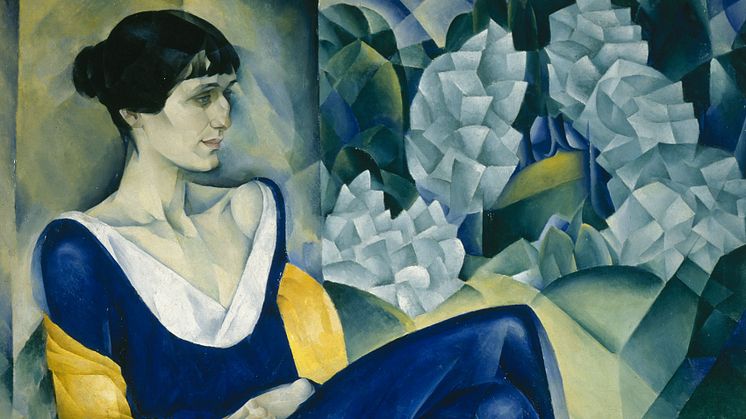
Press release -
Russian art coming to Nationalmuseum this autumn
Following the
success of the Peredvizhniki exhibition,
Nationalmuseum is featuring Russian art in a wider perspective this autumn. From Tsars to Commissars will be an
exhibition of works by artists who came before and after the Peredvizhniki.
Co-produced with the Russian Museum in St Petersburg, the exhibition will
include Russian and Soviet art from the 19th century through to 1960.
The Peredvizhniki – Pioneers of Russian Painting, which appeared in the autumn of 2011, was one of Nationalmuseum’s best-attended exhibitions in recent years. This autumn’s exhibition will widen the perspective to cover artists who came before and after the Peredvizhniki, starting in the early 19th century and continuing through to the latter part of the Soviet era. The exhibition will be an opportunity for Swedish visitors to experience a rich, multifaceted artistic culture that remains largely unknown in western Europe. The exhibits are from the Russian Museum in St Petersburg, home to the world’s largest collection of Russian art, and will include several prominent works from among the museum’s treasures.
From Tsars to Commissars will present some of the art produced by a society that underwent massive changes during the 150-year period covered by the exhibition: from the Tsarist empire through the revolutions and upheavals of the 1910s and ’20s to the Stalinist era and the Cold War, when the Soviet Union became a superpower. Recurring themes include unemancipated peasants, Orthodox Christian imagery and traditions, and the consequences of social upheaval and world war. Narrative engagement and strong emotional expression typify many of the works in the exhibition. Examples of epic scale can be seen in both 19th-century realism and the propaganda art of the Stalinist era.
Russian art history also includes some of the true pioneers of early 20th-century modernism. Kazimir Malevich and Vasily Kandinsky, long considered two of the world’s greatest artists, broke new ground with a style of painting that distanced itself from realism and the narrative tradition. Also on show will be works by 20th-century painters less familiar to international audiences, such as Pavel Filonov, who developed highly personal imagery inspired by folk art and pictures drawn by psychiatric patients. The Soviet regime banned Filonov from exhibiting his works in public.
For long periods, Russian artists worked under repressive regimes that imposed very restrictive rules regarding form and content. In Tsarist times there was strict censorship, and during Stalin’s leadership of the Soviet Union, artists were expected to serve the interests of the government. The officially sanctioned art of the Stalinist era, known as socialist realism, portrayed the progress made by Soviet society and the strength and dynamism of citizens. Despite adapting to the requirements of the Soviet regime, some artists still managed to create visually interesting works. A leading example is Alexander Deineka, who depicted modern industrial scenes and the catastrophic impact of the Second World War.
The exhibition will comprise a total of 65 oil paintings by 40 artists, all on loan from the Russian Museum. Featured artists will include Ivan Aivazovsky, Alexey Venetsianov, Nathan Altman, Natalia Goncharova, Alexander Deineka, Vasily Kandinsky, Isaac Levitan, Kazimir Malevich and Marc Chagall. An exhibition catalogue will be published in Swedish and English, including illustrations of all the artworks with commentary by experts from the Russian Museum.
From Tsars to Commissars. Russian and Soviet Painting from the State Russian Museum will be on show in Nationalmuseum’s temporary venue at Konstakademien, Fredsgatan 12, Stockholm, from 2 October 2014 until 11 January 2015.
Further information
Per Hedström, Director
of Exhibitions, per.hedstrom@nationalmuseum.se, +46 8 5195 4356
Hanna Tottmar, Press
Officer, hanna.tottmar@nationalmuseum.se, +46 767 23 46 32
Caption
Nathan Altman, Portrait of the Poet Anna Akhmatova, née
Gorenko, 1914. © 2014, State Russian Museum, St. Petersburg.
Special thanks go to Anne-Marie and Herbert Lembcke, who were actively involved in the entire exhibition project from concept to implementation. Through their Ad Infinitum Foundation, they provided generous financial support for the exhibition, and valuable input in the form of ideas, contacts, knowledge and experience.
Categories
Nationalmuseum is Sweden’s premier museum of art and design. The collections comprise older paintings, sculpture, drawings and graphic art, and applied art and design up to the present day. The museum building is currently under renovation and scheduled to open again in 2017. In the meantime, the museum will continue its activities through collaborations, touring exhibitions and a temporary venue at the Royal Swedish Academy of Fine Arts, Fredsgatan 12, Stockholm. Nationalmuseum collaborates with Svenska Dagbladet, Fältman & Malmén and Grand Hôtel Stockholm. For more information visit www.nationalmuseum.se.

